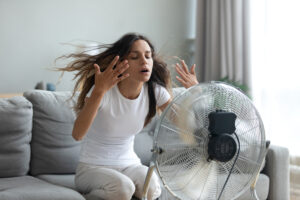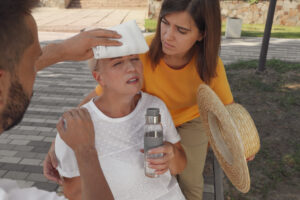
August 1, 2022
Heat Stroke Awareness Month at Coryell Health
Texas heat is no joke, records have crashed as temperatures spike amid an unrelenting heat wave. Heat stroke, also known as sunstroke, is the most serious form of heat injury and is considered a medical emergency. Always be aware of the effects heat can have on your body because what starts as heat exhaustion can lead to heat stroke, which can be fatal if left untreated. Also known as sunstroke, heat stroke is the most serious form of heat injury and is considered a medical emergency. August is Heat Stroke Awareness Month and Coryell Health is here to ensure you have all the facts you need to stay safe.
What is heat stroke?
Heat stroke results from prolonged exposure to high temperatures – usually in combination with dehydration – which leads to failure of the body’s temperature control system. Symptoms include:
- Body temperature above 103°F
- Red, hot, and dry skin with no sweating
- Rapid, strong pulse
- Throbbing headache
- Dizziness and nausea
- Confusion, disorientation and fainting

Am I at risk of having a heat stroke?
Under certain conditions, anyone can be susceptible to having a heat stroke. Pay close attention to your body’s response to heat if you:
- Have underlying, ongoing health issues
- Are over 65 years of age
- Care for children under four years old
- Are overweight, diabetic or taking certain medications
High temperatures can damage the brain and other vital organs, so it’s essential to know about your personal health concerns and pay attention to how you feel in the heat. Be sure to talk with your doctor if you have any specific concerns related to your own risk of having a heat stroke.
How can I be proactive against risk factors and avoid heat stroke?
With fall sports in full swing – football, cheerleading, cross country, tennis and golf – there is an increased risk of heat exhaustion and stroke. Physical activity in hot conditions isn’t ideal. Make sure you’re near air conditioning and, if possible, wait until cooler parts of the day to go outside. Don’t overwork yourself, drink plenty of water (even when you aren’t thirsty) and wear lightweight, light-colored, loose-fitting clothing.

What to do if I or someone nearby is experiencing heat stroke?
- Seek immediate help by calling 911 and give first aid until paramedics arrive
- In the meantime, try to cool down
- Move into the shade or indoors
- Remove excess clothing
- Fan air over the patient while wetting their skin with water
- Use cold water, ice packs, fans, or wet towels on the head and neck area to relieve symptoms
Your health and safety are important to Coryell. If you have more questions about heat stroke or other health concerns, call (254) 865-8251 to schedule an appointment with one of our trusted physicians.
 Skip to content
Skip to content
